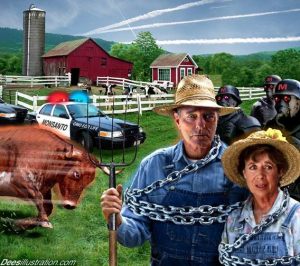February 4, 2010 by Bob Livingston

In the coming months and years, self sufficiency will be the most important concept to our survival. In fact the words survival and self sufficiency are interchangeable and synonymous.
The idea of self sufficiency and survival are hard and harsh concepts to Americans who are in every way dependent on the system. I fear that most may one day be very hungry and forced to resort to stealing their food.
I have often remarked that an honest man will steal if he and his family are hungry. And if desperate enough, he may plunder or may even kill.
The only exception to this is the age group that was born in the 1930s. This small group could easily revert to the land without having a nervous breakdown.
If you have ever watched the movie, Gone With the Wind, you remember the desperate conditions people endured just after the Civil War. Prior to the war Scarlet O’Hara had the finest things that life in the Old South could give, but the war and devastation reduced her to poverty. When the war was over she still had the land. But with everything gone except the land, Scarlet was reduced to living on turnips and whatever she could grow literally with her hands.
That scene happened for real in Germany during World War I. Turnips became survival.
 |
| For more on food and water storage, and everything you need to prepare for the hard times that are coming, see my special report, How to Survive the Collapse of Civilization. |
But this doesn’t have to happen to you if you take small but determined action while there is yet time.
Oh, you have trouble believing that Scarlet’s plight could happen to you? Suppose you take my suggestion and prepare, and of all horrors, nothing bad happens? Well, everything that you have done to prepare—everything you have stored—you can consume.
Plus, you will have on hand food bought before the coming inflation makes limited food available at very high prices.
Most low-income people are having trouble getting affordable food now. Look around and you will see all the people who are overweight because they only get mostly low-cost high-carbohydrate food.
Some readers have asked lately how to go about storing food and how they can prepare for when times get rough. Here are answers to some of them:
What food items to store? Try to store food that has shelf-life and always rotate it. I bought a ton of brown rice 40 years ago and I am still eating it, after raising my children on it. I used diatomaceous earth to preserve it. Diatomaceous earth dehydrates bugs in grains.
Canned goods—fruits, vegetables and meats—have an expiration date. Buy extra every trip you make to the grocery store and be sure your rotate your stock to use the oldest first.
There are food kits available online and in some survival/outdoor stores that will sustain you through emergencies. Some of these contain all you need for survival and are marked to show how many people can survive off the food included and for how long.
How much to store? That is an individual problem and a difficult question that contains no set answer. The best bet is to watch what your family eats in a week and make note of it (how many servings of meat, vegetables, fruit and grains). Then you’ll have an idea of how much must be set aside for each week you think an emergency might exist. As for water, experts say each person needs about two gallons per day for drinking, cooking and hygiene. A minimum of three days supply should be kept on hand, and more is better.
Store seeds in your refrigerator. All who want a garden should store natural seeds, not hybrid seeds. Store some each year from your crop.
(Editor’s note: For more detailed information on surviving food and water shortages and more, see my special report, How to Survive the Collapse of Civilization. I have also reviewed an excellent book on food and water storage entitled Emergency Food Storage and Survival Handbook. Click on the title to read the review and for a link to purchase the book.







 As you may know the US government is trying to pass a law, HR2749, which is about imposing totalitarian control on the food supply (such as mandating GMO-food) and restricting anything natural or healthy, such as access to supplements or even any natural food. Our health and very lives and the lives of our children depend on this being stopped. This is not an exaggeration. Our food supply will be placed in the hands of large factory farms and conglomerates like Monsanto who’s only objective is profits.
As you may know the US government is trying to pass a law, HR2749, which is about imposing totalitarian control on the food supply (such as mandating GMO-food) and restricting anything natural or healthy, such as access to supplements or even any natural food. Our health and very lives and the lives of our children depend on this being stopped. This is not an exaggeration. Our food supply will be placed in the hands of large factory farms and conglomerates like Monsanto who’s only objective is profits.